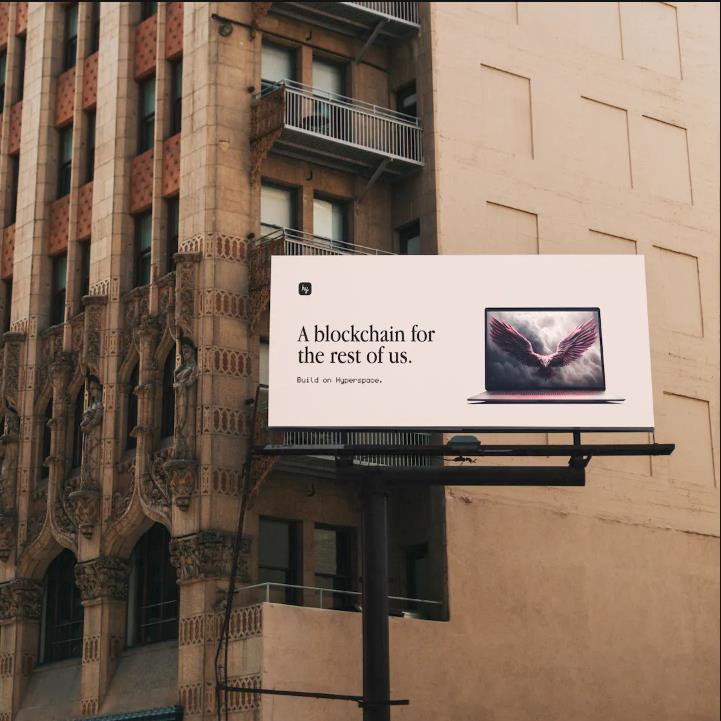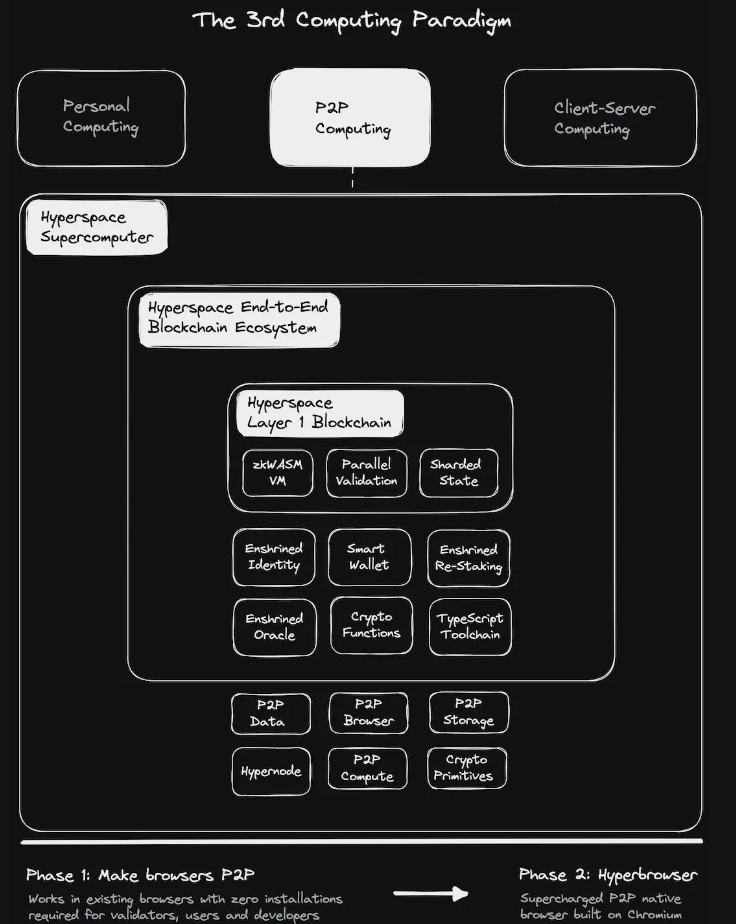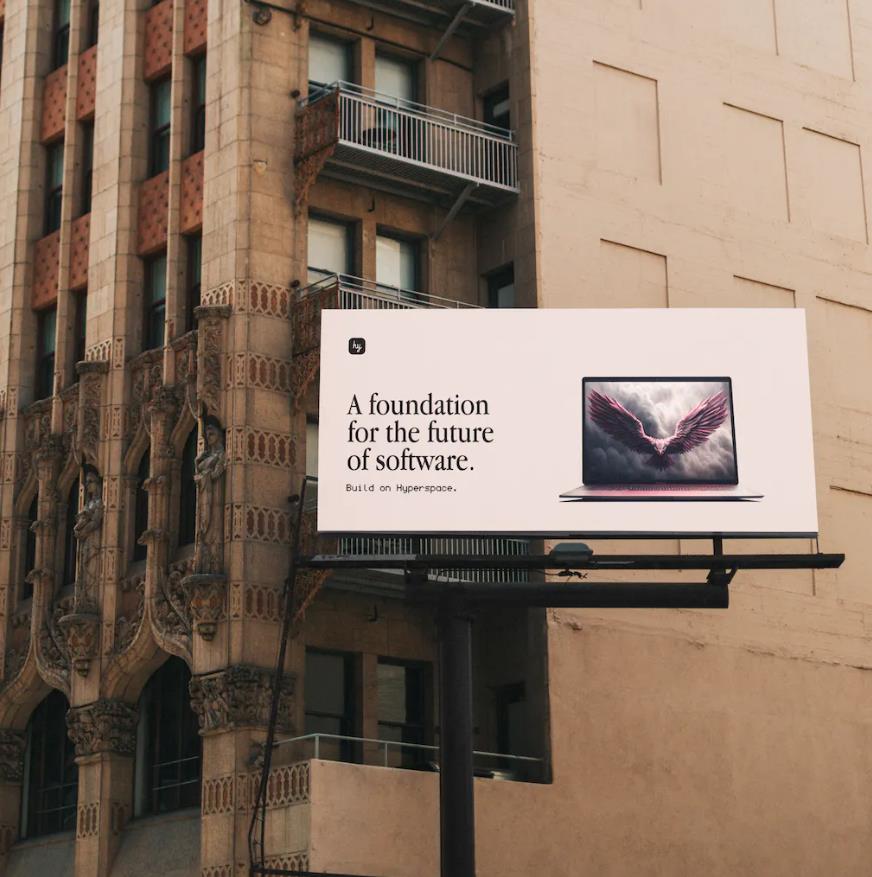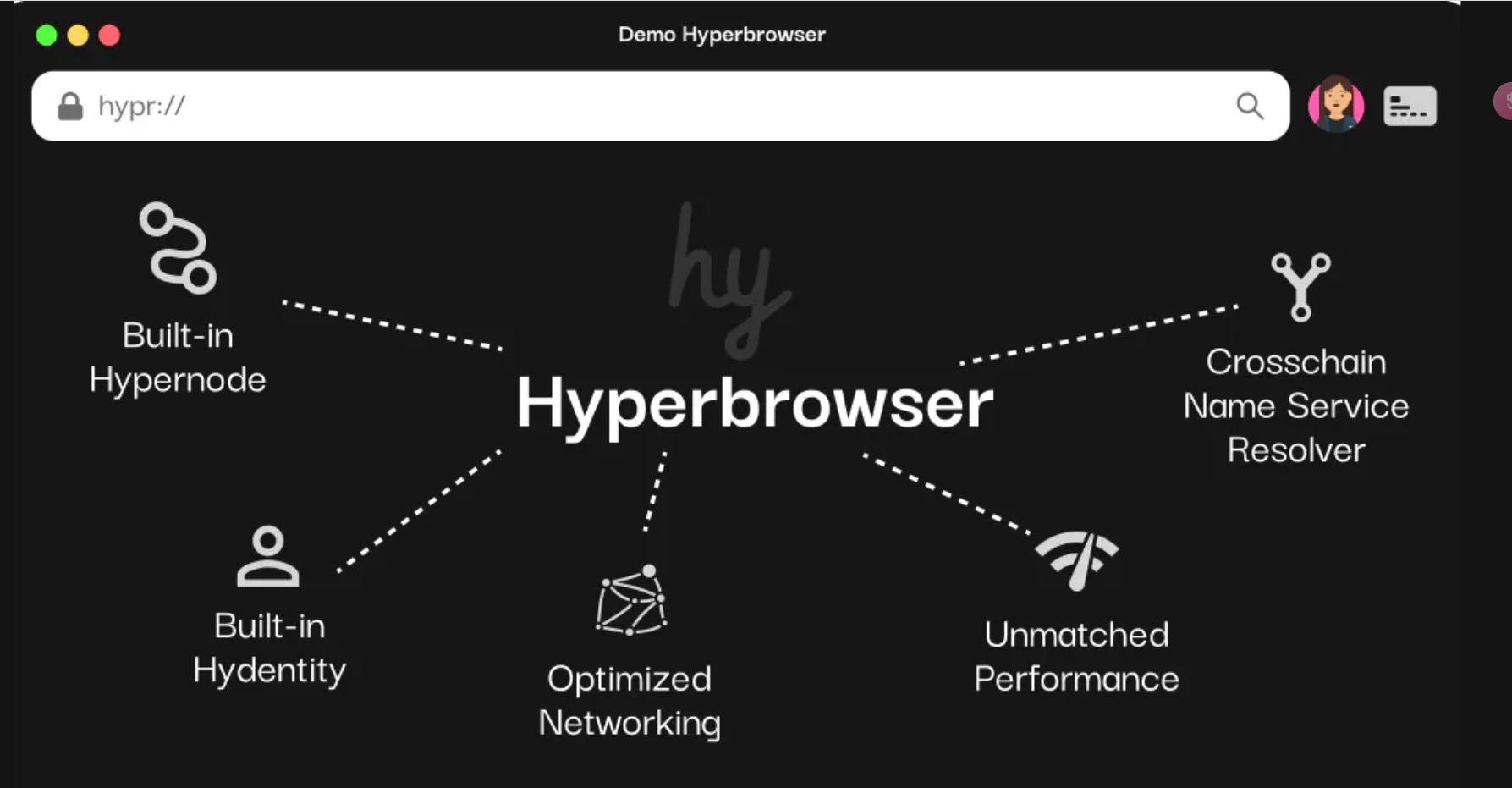Writing: Hyperspace
Compiled by: Deep Tide TechFlow
Editor's Note: This is a new type of L1 that has not yet received widespread attention, but has already been noticed by many industry professionals, including Marc Andreessen, founding partner of a16z. This article comes from the initial self-description of the project, explaining why it chose to start building a new blockchain in 2023 and its long-term vision for the future.
I am a time traveler from the year 2025. This is a moment when the whole world knows who Satoshi Nakamoto is, and blockchain is used by hundreds of millions of people every day. These two statements are closely related, and our current reality stems from the story you are about to read.
On January 24, 2023, a group known as Gutenberg announced the launch of Hyperspace, a new type of supercomputer supported by a fully browser-based blockchain. In hindsight, it has become one of the most important products in the history of computing since the launch of the Macintosh on January 24, 1984. When you read this in 2023, it sounds absurd, but it is not the case in our world. Our world is very different from yours—it was created by a group of people who should not have been doing these things, but did so through sheer willpower.
Why Build a New Blockchain in 2023?

To understand how far-fetched the invention of Hyperspace was, consider that by early 2023, there were already dozens of well-funded blockchains in existence. The community at the time believed that everything that needed to be invented had already been invented, which was a result of people not understanding the practicality of blockchain. The problem was that the community was treating blockchain as an extension of research projects, and these frictions were being overlooked, leaving most others unfortunate to extract all the value they could from these systems.
We learned how to build a blockchain from Satoshi, but not why to build a blockchain.
In this world, Satoshi's information has been lost. It is information about simplicity, providing equal opportunities for everyone at the starting point, and sharing the economic benefits of the entire network. It is information about making sacrifices for broader interests, sacrifices in the form of choosing to live an ordinary life, not seeking honor for your invention, and deliberately not mining as much as you could have—once again choosing the interests of the network. Remember, in 2009, a college student could download the Bitcoin client and earn 50 bitcoins simply by participating as a full network participant. At the time, these bitcoins were almost worthless, but if the network took off, it provided equal opportunities for everyone.
The blockchain era swept the globe.
By 2022, blockchain had fully entered the era of franchising, just like a local merchant deciding to operate a McDonald's franchise. This was an investment: deep financial and technical resources to become a full validator. Block production was actively shifted to centralized entities, a carefully designed decision, such as Ethereum, which at one point had over 80% of production done by a single corporate entity. There were only a few thousand full validators, mainly located in specific data centers in AWS Virginia and Germany. Many other projects masqueraded as blockchains, but were actually only slightly more decentralized than traditional enterprise databases. A liquidity collateral derivative entity with about 100 members theoretically held a significant governance stake in many proof-of-stake blockchains. Transactions could be subject to review simply by appearing on the list of a specific obscure bureaucrat in a particular country, and the user experience would significantly deteriorate. After 2022, the world began to associate cryptocurrencies with greed rather than utility.
Apart from speculators, ordinary people were excluded from the world of blockchain.
While almost everyone in the world could not afford to receive full network rewards (considering that in 2022 only 6% of American households could afford to become Ethereum full validators), developers were required to learn complex programming languages and figure out how to connect all the parts in the blockchain ecosystem at the time. This led to an active blockchain developer population of about 1,000 people, while there were over 100 million software developers worldwide. Users were willing to make fewer sacrifices due to enough friction points. We did not build practical systems and applications for people in Manila, Casablanca, or even Phoenix, Arizona. This led to fundamental inequality, where those with enough technical and financial resources became the primary beneficiaries of the powerful new blockchain world, which was unfair.
People saw the revolution of smart contracts in the 2010s, but did not experience it firsthand.
Ethereum was the most amazing technological project of the 2010s, sparking a wave of creativity. However, even by 2022, the idea of building Uber on Ethereum was still just a discussion. Why did this not actually happen? Why were high commission fees from proprietary database providers still being used even in the blockchain community? The widespread disruption of the real world by blockchain had not yet been achieved. Why did no other blockchain bring practical, everyday utility to anyone? Why was blockchain linked to market sentiment, but not to GDP?
The urgent need is for a fresh start, to rethink everything from scratch. A passionate amateur team might ask some absurd questions, such as:
Well, what does a more decentralized blockchain than Ethereum look like?
How can we reintroduce the early spirit of participation from Bitcoin and BitTorrent to involve ordinary people more widely in blockchain?
Can we provide a fully browser-native end-to-end blockchain experience for validators, users, and developers?
Why should we pay computing fees on other blockchain systems to "franchise owners" when people can simply use their own browsers?
What kind of blockchain system design can allow tens of millions of people to use it simultaneously, from Manila to Mumbai?
The opening page of the initial draft of the Hyperspace paper: It introduces detailed P2P browser engineering innovations, a runtime called Nanochain based on ZK-Proof and WebAssembly, a super decentralized parallel execution and parallel block production architecture called Interstellar, all leveraging a large-scale decentralized state sub-protocol called Groot. This article explains why the design is secure, how it works, how it can be extended, and the mathematical and engineering basis for its speed. It further explains how we have massively simplified the end-to-end experience for users, developers, and validators.

All zombie blockchains are fast and cheap. But our pursuit is to design the cheapest and fastest system under high concurrency.
Designing Hyperspace: Our Thoughts
When Hyperspace announced its development, the blockchain landscape looked like this:

This blockchain is the "microchip" of the entire new browser-based P2P supercomputer, which was built over the next few years and was the fastest L1 and most powerful design announced at the time. It was a combination of fundamental new innovations learned/iterated rapidly based on industry observations, leading to a cross-network parallel execution zkVM design (beyond the prevalent powerful server designs in other blockchains), and parallel verification. A series of groundbreaking technologies of Hyperspace at the time included:
Browser P2P Network: Enhancing Browser-Run Blockchain Protocol Without Users Needing to Download Anything
The solution found by the Gutenberg team for the browser network is the most groundbreaking of this generation, ushering in a fundamentally peer-to-peer new era of networking.
As part of the first set of engineering challenges, the team developed a network library that enhances comprehensive peer-to-peer connections between existing browsers: from discovering these nodes to establishing stable connections for data exchange. Running a full blockchain node no longer requires downloading and installing software on a computer. This will enable future blockchains and decentralized services to be fully browser-based in the near future, opening up a world of decentralized network applications. Imagine the entire front end of these applications running on this P2P network, without the need for large-scale tech cloud services. This provides users with better privacy protection, reduces latency in certain cases, and ultimately lowers costs, while providing a permanently running, highly available permissionless network.
PS: If you liked Nostr at the end of 2022, you will also like the Hyperspace network protocol in 2023, as it offers similar benefits but now with full P2P.
Web zkVM: Building a Fast and Secure Runtime Based on ZK + WebAssembly in the Browser, Capable of Generating Execution Proofs
Hyperspace utilizes a new web zkVM in the user's own browser to execute smart contracts and captures execution proof traces in STARK. These STARKs ("actions") are packaged into a single SNARK transaction and propagated through the network. This design achieves massive parallel execution. This plays a crucial role in parallel verification as it is known which specific states are affected. Overall, this design achieves pre-L1 determinism of 10ms-50ms in the same region, providing a faster experience than so-called web2 and enabling new web3 multi-user use cases.
Here is a link to a live demonstration of the Hyperspace web zkVM - click here to try it out!
This website embeds a zero-knowledge runtime. To see how fast it is, try our simulated limit. When you press play, over the next ten seconds, send as many actions to it as possible by pressing any key/mouse click or touch. Each time an action is triggered, the runtime executes a piece of WebAssembly (WASM) code simulating state retrieval/modification, then generates its execution proof (turning the block green). All these proofs are then combined into a transaction in the Hyperspace system.
If you think this is fast enough, imagine this as the foundation for the user experience of social, gaming, financial, and market applications.
3. Parallel Verification: Using a Multi-Lane Highway Approach for Module Construction and Verification, Highly Practical for Global Use
- Inspired by the unicorn and enhanced Hotstuff
A group of decentralized nodes effectively package transactions into blocks using DAG and weighted algorithms, then send them to specific validator shards.
- Conflict-free shard consensus
These shards can also directly receive transactions, further build blocks, and execute distributed consensus, thereby parallelly verifying multiple microblocks without conflicts.
- Revolutionary design for shard state
Hyperspace was designed with a shard state strategy from the beginning, which prevents the state bloat problem that affects all monolithic L1 builds to this day. Ethereum's own tech lead once referred to it as a "death spiral" because the state grows by 1GB every day. Hyperspace aims to solve this problem from the start.
- Optimization for cross-program calls
Overall, the system design considers the worst-case scenario: maximum cross-program calls. This requires a rethink of the entire verification and execution layer, by completely removing execution bottlenecks in validators, achieving parallel verification, and true platform scalability.
- Inherent horizontal scaling design
The system design allows for the continuous addition of validator shards as the system grows, as it does not require high system requirements for individual block-producing nodes. This has always been the foundation of the Gutenberg team's philosophy: to enable ordinary people to become full network participants using simple laptops and browsers.
Hyperspace Incorporates Identity, Oracle, and Re-staking into the Base Protocol, Achieving High-Quality UX and DX
Apple's approach to its products has something in common with Vitalik's suggestion on how to build a new blockchain: integrated experience.
Hyperspace incorporates oracles into the core protocol, where existing validators can join using browser-based client software to start providing oracle services to the network. By leveraging the re-staking mechanism integrated into the base protocol, it enhances security and expands service scope, such as cross-chain primitives, automation, time management, and Web2 data. This build also greatly simplifies direct integration of dApps built on Ethereum, Solana, Polkadot, and Near with Hyperspace, compared to existing oracles. From a developer's perspective, this sanctified oracle provides low-level primitives, simplifying the handling of off-chain data compared to existing oracles.
Hyperspace provides an integrated identity and smart wallet sub-protocol, introducing a new way to manage independent identities in the Hyperspace ecosystem. These are called session wallets, derived encrypted from the user's main wallet, abstracting them as multiple identities for their specific applications. This design is inspired by traditional web user experience, giving users complete control over the applications they authorize and spending limits. Overall, this zero-install approach simplifies the adoption process for beginners while providing practical security options for advanced users. This sub-protocol also specifies token/NFT standards, making it easier for smart contract developers to integrate while achieving composability. This unlocks new design space for completely suitable multi-user scenarios with unconfirmed transactions.
Designed for Developers. "The best code line is the one you never have to write, that never breaks, and that you never have to maintain." - Steve Jobs, 1997 keynote.
Hyperspace uses TypeScript as the primary smart contract development language, combined with a software development kit (SDK) that enables millions of amateur web developers to quickly adapt to smart contracts. The protocol also sanctifies multiple sub-protocols and decentralized services, providing developers with an integrated experience that simplifies the construction of complex applications.
The design of smart contract wallets provides context-based access, which is beneficial for developers as it provides security for users, builds trust, and promotes more usage. Overall, Hyperspace's design aims to provide the fastest blockchain experience, with pre-L1 determinism equivalent to Google search speed in the same region.
Just as Uber Disrupted the Taxi License Business, Hyperspace Disrupts Full Node Validator Business - Making it Democratic

The cryptoeconomics of Hyperspace are driven by some fundamental principles, including:
- Even college students using laptops should be able to earn substantial rewards by simply using a browser and fully participating in this new network.
- The deflationary model, where the base token appreciates through re-staking, thereby enhancing the network's security.
- Maintaining blockchain independence from any governance mechanisms imposed by any external liquidity staking derivatives. If all other PoS blockchains are subject to scrutiny for any reason, at least Hyperspace should remain viable.
- Maximally decentralized block production among ordinary people, rather than potentially scrutinized and compromised by corporate entities, to enhance the permissionless user experience.
What People Experience: The Era of Supercomputing

The concept of a "supercomputer" used to refer to a set of extremely powerful computers connected and located in the same building. Hyperspace applies this concept to the level of hundreds of millions of people using only laptops and browsers, without any installation. This entirely P2P "computer" is built on three inevitable trends of the 2020s:
- Laptops and other personal computing devices have become exceptionally powerful and simultaneously more affordable, making running computations in data centers obsolete.
- Bandwidth has become faster and cheaper, while unlocking new capabilities through improved browser P2P networks.
- The era of zero-knowledge proofs and WebAssembly allows near-native speed computation on computers, even within browsers, without any installation.
- Hyperspace is a way for ordinary people to experience the efficient network capabilities formed by browser nodes directly, and to perform various functions typically accomplished using proprietary APIs and cloud providers. More and more of our era's "Shopify, Uber, Airbnb, and even ChatGPT" are inevitably running on a P2P network maintained by ordinary network users, rather than being subject to a specific company and its rules. Software functionality has been massively commoditized, marking the era of smart contracts.
The world we envision is one where everything is related to cryptocurrency.
With Hyperspace, you no longer need to pay high fees to third-party closed databases just to execute business logic. The code is open, active, and available. You can directly transact efficiently with others using your own computer. You can easily access millions of smart contracts or quickly compose your own. Your data is not locked; you own and control it. You can also choose to participate in this network and provide computing resources to improve network health and earn rewards. Think BitTorrent.
This is a browser-driven peer-to-peer computing world, without the need to download anything. The Hyperspace blockchain operates invisibly, like a microchip—what users experience is the power of the entire network.
We are improving the fundamental network experience.

The Final Battle: Fully Peer-to-Peer Native Browser
"The network is the platform" - Marc Andreessen

While mainstream browser manufacturers continue to make underlying hardware and software exceptionally powerful, they have not fully aligned with the peer-to-peer computing paradigm. This required the Gutenberg team to propose several innovations related to the browser network, involving some trade-offs. Ultimately, the ultimate goal has become to build the Hyperbrowser in order to provide users with the highest quality and closest to native Web3 experience.
As a dedicated browser built on Chromium, it will enable zk proof runtimes to achieve near-native performance and even allow home node operators to earn more by providing direct GPU and storage access. This browser will surpass the limitations of the Chromium network stack, becoming a native peer-to-peer browser, and making authentication using a solidified identity layer more convenient for end users. Imagine being able to enter someone's identity address directly in the browser and view their profile, send tokens, NFTs, and more.
As the runtime is also local to the browser, the loading speed of decentralized web applications will be greatly improved. This is achieved by informing the server of the location of dApp storage and the fact that the requester is using Hyperbrowser. The server will then send a smaller application containing only smart contracts, CSS, HTML, and JavaScript—without additional runtimes. This will save bandwidth by significantly reducing the size required to load the application, providing a faster experience while improving decentralization. The world of tens of millions of smart contracts becoming native web objects is fundamentally beneficial to consumers.
Overall, Hyperspace aims to elevate the standard of web browsers in the 2020s. The client-server browsers of the 2010s were great, but now it's time to launch powerful peer-to-peer software across devices.

Building with AI, Deploying on Hyperspace

A Brief Overview of How the Software World Works Now:
It is now 2025, and software creation is accomplished by several generations of AI products following ChatGPT and similar models, while software deployment and usage occur on accelerated P2P "supercomputers" like Hyperspace. Your AI agent customizes an end-to-end personalized software experience for you based on your history and basic prompts, and uses Hyperspace as the deployment layer.
Here's an example of renting out a spare room using AI:
To simply rent out a room to a traveler, you don't have to visit a website, click many buttons, manually select prices, pay expensive and arbitrary commission fees, while also locking up your data! Instead, the situation is as follows: Your AI agent already understands your intent and schedule, finds the most suitable among millions of trustworthy and cost-effective auction smart contracts on Hyperspace, and packages a feature-rich software experience for you using the data you provide—all running entirely on a fully peer-to-peer network spliced together by Hyperspace using cryptographic economic incentives.
Even these millions of smart contracts are not built by blockchain rocket scientists from the early 2020s, but by AI models using simple prompts from ordinary network users or thousands of TypeScript developers. Now, by saying a sentence, you can rent out your room at the best price and almost without paying any commission fees, as smart contracts automatically compete to provide the service for you! We have transitioned from automatic competition among advertisers in Google search results to automatic competition among smart contracts on Hyperspace, providing you with the best software utility.
Software has been commoditized like electricity. Other use cases include:
- P2P Discord and other messaging applications.
- P2P Netflix, Youtube, and other file sharing systems.
- P2P Notion and other note-taking systems.
- P2P metaverse, further realized through technologies like WebGPU and WebXR. In MMORPG games, everyone moves on a connected application map in the 3D world.
- P2P games: one player hosts, and other players can join directly.
- P2P AI: each user jointly trains models using only their local user data.
The idea of a single company owning your data now seems like a distant memory. We have very powerful laptops that seamlessly connect to each other through fast and affordable bandwidth available now, using the Hyperspace supercomputer. This is our new world, and what's exciting is that we are still in the early stages of understanding the full power of such a network.
免责声明:本文章仅代表作者个人观点,不代表本平台的立场和观点。本文章仅供信息分享,不构成对任何人的任何投资建议。用户与作者之间的任何争议,与本平台无关。如网页中刊载的文章或图片涉及侵权,请提供相关的权利证明和身份证明发送邮件到support@aicoin.com,本平台相关工作人员将会进行核查。




